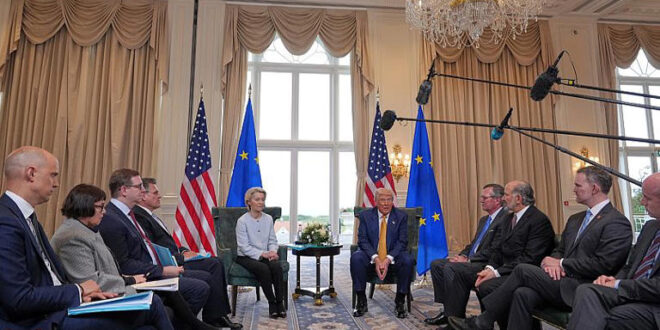President Trump said he reached a trade deal with the European Union late on Sunday, avoiding a trade war with the US’s largest trading partner and marking his biggest deal so far in his attempt to remake the global trading system through higher tariffs for U.S. trading partners.
Trump made the announcement at Trump Turnberry, his seaside golf resort in western Scotland, after meeting with European Commission President Ursula von der Leyen, who leads the EU’s executive body.
EU backs down to Trump: The pact comes less than a week before a Friday deadline for President Donald Trump’s higher tariffs to take effect on August 1. The president in May threatened to impose a 50% duty on nearly all EU goods, adding pressure that accelerated negotiations, before lowering that to 30%, writes Tyler Durden at Zerohedge.

EU backs down to Trump: Trump said the U.S. would set a baseline tariff of 15% for European goods, including automobiles. He said steel and aluminum tariffs, which are currently at 50%, would remain unchanged. He added that the EU had agreed as part of the deal to buy $750 billion worth of energy products from the US, and the EU would agree to invest $600 billion more than previously in the US, although similar to the $550BN “investment” promised by Japan, this is unlikely to every materialize.
Adding to the list of ludicrously big numbers disclosed (or as the case may be undisclosed) today, Trump also said that the EU would buy “a vast amount” of military equipment, and while he explained that “we don’t know what number is” but added that the US makes “the best military equipment in the world so you have to do that.”
RELATED ARTICLES:
- The Epstein Files Hoax? Trump Kicked Epstein Out Of Mar-a-Lago; Turned Down Invite To his Island
- Trump Liberation Day Revolution: The End of Globalist Injustice
- Trump Tariff Plan marks the end of the Marxist-socialist tariff system that punished the West
- Trump tariff revolution: The existing international tariff system discriminates against the West favoring Global South
- 2025: The fall of globalism, the rise of Trumpism
- 2025: Colossal Changes as Trump Shreds Socialist-Globalist Norms and Pushes Conservative Values
EU backs down to Trump: To summarize, the US has agreed:
- To purchase $750 billion in energy
- Invest $600 billion in the US on top of existing investments
- Open up countries’ markets to trade with US at zero tariffs
- Purchase “vast amounts” of military equipment
Officials report that both pharma and autos will be hit at 15% (Trump implied that’s not the case so there appears to be some continued friction and/or negotiations), while von der Leyen says there will be zero-for-zero tariffs on aircraft components and some chemicals.
To get the tariff down from the 30% that had been threatened, the EU has agreed to buy a total $750 bn of US energy and increase its investment into the US by $600 bn. Note that it was Trump’s stance prior to the Liberation Day that the EU could get a deal by buying US energy. The EU will also purchase US military/defence equipment, as well as US LNG.
“I think it’s going to be great for both parties, I think your various countries are very happy about this,” Trump said, sitting alongside von der Leyen. The two met for about an hour with their top representatives.
“We made it,” von der Leyen said. She said the two sides wanted to rebalance their trade relationship, “and we wanted to do it in a way that trade goes on between the two of us across the Atlantic.”
Currently, the EU faces a 10% baseline tariff on most of its goods exports to the U.S., as well as a 25% tariff on its auto industry and a 50% tariff for steel and aluminum.
“I think that basically concludes the deal,” Trump told reporters at his golf club in Turnberry, Scotland. “It’s the biggest of all the deals.”
The terms disclosed on Sunday suggest that 15% is likely a new minimum tariff level for most American trading partners. Economists and trade analysts say that tariffs at that level will have an impact on companies’ decisions and are expected to contribute to higher prices for Americans, but won’t stop global trade flows.
“They are not at the level where the global economy burns down,” said Dmitry Grozoubinski, senior trade adviser at Aurora Macro Strategies.
The deal comes after a flurry of recent trade announcements. Trump said this past week that he had reached a deal with Japan, another top U.S. trading partner, which put baseline tariffs at 15%. Separate agreements set Vietnam’s baseline tariff level at 20% and established a 19% rate for the Philippines and Indonesia, Trump has said.
The U.K. has the lowest tariffs Trump has so far agreed to as part of a deal, at 10%. Trump also was expected to iron out final details of the U.K. agreement in meetings with British Prime Minister Keir Starmer on Sunday and Monday.
The EU pact removes a major risk for markets and the global economy, a trade war involving $1.7 trillion worth of cross-border commerce, even though it means European shipments to the US are getting hit with a higher tax at the border.
The goals, Trump said, were more production in the US and wider access for American exporters to the European market. Von der Leyen acknowledged that part of the drive behind the talks was a rebalancing of trade, but cast it as beneficial for both sides.
“The starting point was an imbalance,” von der Leyen said. “We wanted to rebalance the trade we made, and we wanted to do it in a way that trade goes on between the two of us across the Atlantic, because the two biggest economies should have a good trade flow.”
As Bloomberg notes, US and European negotiators had been zeroing in on an agreement this past week. Officials have discussed terms for a quota system for steel and aluminum imports, which would face a lower import tax below a certain threshold and would be charged the regular 50% rate above it. The EU had also been seeking quotas and a ceiling on future industry-specific tariffs, but it’s unclear if the initial agreement will shield the bloc from potential levies that have yet to be implemented.
The announcement capped off months of often tense shuttle diplomacy between Brussels and Washington. The EU had prepared to put levies on about €100 billion ($117 billion), about a third of American exports to the bloc, if a deal wasn’t reached and Trump followed through on his warning.
For weeks, the EU has indicated a willingness to accept an unbalanced pact involving a reduced rate of around 15%, while seeking relief on sectoral tariffs critical to the European economy. The US president has also imposed 25% levies on cars and double that rate on steel and aluminum, as well as copper.
The deal comes just days after we learned that in June the US collected a new record in tariff revenue, some $26.6 billion: a number which annualizes to an impressive $320 billion.
Several exporters in Asia, including Indonesia, the Philippines and Japan, have negotiated reciprocal rates between 15% to 20%, and the EU saw Japan’s deal for 15% on autos as a breakthrough worth seeking as well. Washington’s talks also continue with Switzerland, South Korea and Taiwan.











